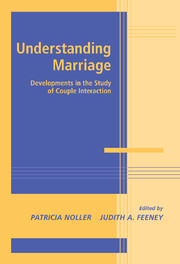Book contents
- Frontmatter
- Contents
- Contribitors
- Introduction
- SECTION ONE THE EFFECT OF COGNITION ON INTERACTION PATTERNS
- SECTION TWO UNDERSTANDING THE IMPORTANCE OF POSITIVE INTERACTION
- SECTION THREE COPING WITH DISAPPOINTMENT, CRITICISM, AND BETRAYAL
- SECTION FOUR POWER, CONFLICT, AND VIOLENCE IN MARITAL INTERACTION
- Marital interaction at important transition periods
- SECTION SIX Interventions for strengthening relationships
- Introduction to Section Six
- 17 Risk Factors, Risk Processes, and the Longitudinal Course of Newlywed Marriage
- 18 Does Working at a Relationship Work? Relationship Self-Regulation and Relationship Outcomes
- Conclusions
- Index
Introduction to Section Six
Published online by Cambridge University Press: 25 July 2009
- Frontmatter
- Contents
- Contribitors
- Introduction
- SECTION ONE THE EFFECT OF COGNITION ON INTERACTION PATTERNS
- SECTION TWO UNDERSTANDING THE IMPORTANCE OF POSITIVE INTERACTION
- SECTION THREE COPING WITH DISAPPOINTMENT, CRITICISM, AND BETRAYAL
- SECTION FOUR POWER, CONFLICT, AND VIOLENCE IN MARITAL INTERACTION
- Marital interaction at important transition periods
- SECTION SIX Interventions for strengthening relationships
- Introduction to Section Six
- 17 Risk Factors, Risk Processes, and the Longitudinal Course of Newlywed Marriage
- 18 Does Working at a Relationship Work? Relationship Self-Regulation and Relationship Outcomes
- Conclusions
- Index
Summary
We have learned a great deal about marital interaction from the extensive research carried out over the last few decades. However, the findings have not always been readily available to the general population. The results of research studies can only help couple relationships to the extent that they find their way into the popular literature, or are applied in the therapeutic context. The chapters in this section emphasize ways in which couple relationships can be strengthened through appropriate intervention.
Story, Rothman, and Bradbury explore the risk factors for marital dysfunction, using a longitudinal study of the first four years of marriage. Their main focus is on the effects of parental divorce and negativity in the family of origin; that is, on the intergenerational transmission of relationship difficulties. Given that these family of origin factors are not, of themselves, amenable to change, an important issue associated with intergenerational transmission concerns the identification of variables that may mediate the effects of negative family-of-origin experiences on marital functioning. Interpersonal processes are particularly relevant in this context, because these processes can be modified by teaching couples appropriate relationship skills.
Story and her colleagues recruited couples in the first six months of marriage, in order to monitor their progress across the critical early years. They also assessed the couples using multiple measures of marital behavior, including problem solving, physical and psychological aggression, and negative affect (coded from a problem solving interaction).
- Type
- Chapter
- Information
- Understanding MarriageDevelopments in the Study of Couple Interaction, pp. 465 - 467Publisher: Cambridge University PressPrint publication year: 2002



